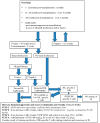BK Polyomavirus in Pediatric Renal Transplantation-What We Know and What We Do Not
- PMID: 38791055
- PMCID: PMC11118040
- DOI: 10.3390/biomedicines12051093
BK Polyomavirus in Pediatric Renal Transplantation-What We Know and What We Do Not
Abstract
BK polyomavirus (BKPyV) is still a real threat in the management of kidney transplantation. Immunosuppressive treatment disrupts the equilibrium between virus replication and immune response, and uncontrolled BKPyV replication leads to nephropathy (BKPyV nephropathy). The first evidence of BKPyV reactivation in transplant recipients is the detection of viral shedding in urine, which appears in 20% to 60% of patients, followed by BKPyV viremia in 10-20% of kidney transplant recipients. BKPyV nephropathy eventually occurs in 1-10% of this population, mainly within the first 2 years post-transplantation, causing graft loss in about half of those patients. Few data exist regarding the pediatric population and we focus on them. In this paper, we review the existing diagnostic methods and summarize the evidence on the role of BKPyV humoral and cellular immunity in modulating the clinical course of BKPyV infection and as potential predictors of the outcome. We look at the known risk factors for BKPyV nephropathy in the immunosuppressed patient. Finally, we propose a sensible clinical attitude in order to screen and manage BKPyV infection in kidney transplant children.
Keywords: BK polyomavirus; BKPyV nephropathy; kidney transplantation.
Conflict of interest statement
The authors declare no conflicts of interests.
Figures
References
Publication types
LinkOut - more resources
Full Text Sources


